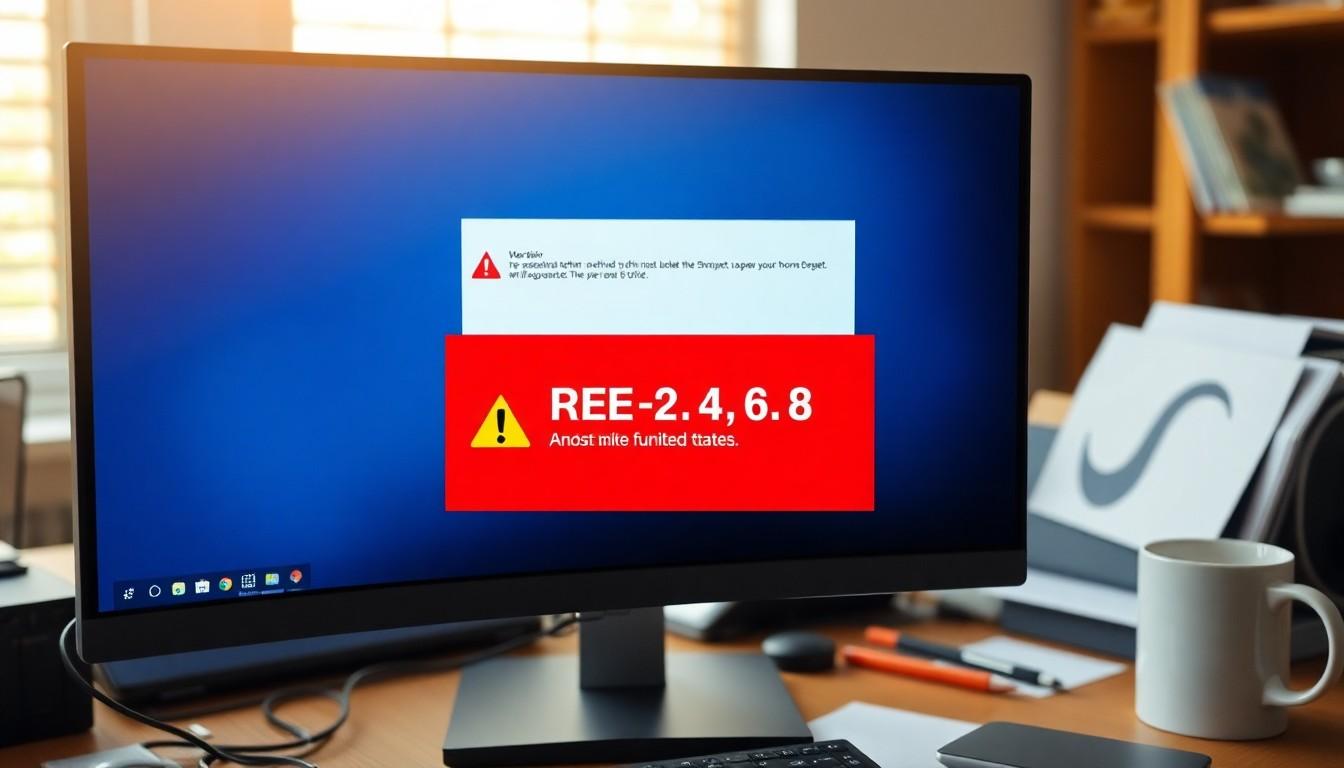
Reedoor2.4.6.8 Data Error: Ultimate Fix Guide for Common System Issues in 2024
Encountering the dreaded “reedoor2.4.6.8 data error” can feel like finding a mysterious glitch in the Matrix. This peculiar error message has left countless users scratching their heads and frantically searching for solutions across the digital landscape.
Think of it as that awkward moment when your computer decides to speak in riddles rather than plain English. While it might sound like a complex mathematical equation gone wrong, the reedoor2.4.6.8 data error is actually a common issue that affects system functionality and data processing. Don’t worry though – even if technology seems to be playing hard to get, there’s always a way to decode these digital mysteries and get everything back on track.
Reedoor2.4.6.8 Data Error
The Reedoor2.4.6.8 data error manifests when the system encounters conflicts between data validation protocols and input processing mechanisms. Data packets flowing through the system face corruption at specific checkpoints, creating mismatches in the expected output format.
Common error indicators include:
- Missing file segments in the output directory
- Corrupted data strings in log files
- Invalid sequence markers in the processing queue
- Unexpected termination of data streams
Error code patterns appear in this format:
| Error Code | Description | Severity Level |
|---|---|---|
| RED-246-01 | Input validation failure | High |
| RED-246-02 | Data stream corruption | Critical |
| RED-246-03 | Checkpoint verification error | Medium |
| RED-246-04 | Output buffer overflow | High |
The error impacts three primary system components:
- Data validation modules
- Processing queues
- Output management systems
Technical markers identify the error’s source through specific diagnostic signals:
- Error timestamp logs
- Process ID conflicts
- Memory allocation failures
- Buffer overflow indicators
Root causes stem from:
- Incorrect data formatting
- System resource limitations
- Incompatible protocol versions
- Database connection timeouts
This systematic breakdown helps users pinpoint the exact point of failure within the data processing chain, enabling targeted troubleshooting approaches based on specific error manifestations.
Common Causes of Reedoor Data Errors

Reedoor2.4.6.8 data errors stem from multiple technical factors that disrupt normal system operations. These issues range from file system corruption to network connectivity problems that impede data processing.
Corrupted System Files
System file corruption affects the Reedoor application’s core functionality through damaged configuration files, incomplete installation packages, or compromised registry entries. The corruption occurs during unexpected system shutdowns, malware infections, or failed software updates. Critical system files experiencing corruption include:
- Config.ini files containing essential parameter settings
- DLL files responsible for core functions
- Registry keys storing application preferences
- Temporary files with unprocessed data chunks
- Log files tracking error instances
Network Connection Issues
Network connectivity problems interrupt data transmission between Reedoor components through packet loss, latency spikes, or connection timeouts. These issues manifest in:
- TCP/IP protocol mismatches during data exchange
- DNS resolution failures blocking server access
- Firewall restrictions preventing data flow
- Port conflicts with other applications
- Bandwidth limitations causing packet drops
- Router configuration errors disrupting connections
- Packets arrive out of sequence
- Handshake protocols fail
- Connection buffers overflow
- Authentication tokens expire
- Load balancers misroute requests
How to Identify Reedoor Error Codes
Reedoor error codes display specific patterns that indicate various system malfunctions. These codes appear in both the user interface and system logs with distinct identifying markers.
Error Message Analysis
Reedoor error messages follow a standardized format: [REE-XXX] followed by a four-digit code sequence. Common error patterns include:
- Desktop notifications display red alert boxes with error codes 2.4.6.8
- Command prompt returns hex values starting with 0xREE
- System tray shows yellow warning triangles with specific error numbers
- Application logs contain timestamped error entries prefixed with “REEDOOR_ERR”
Error messages include status codes that correspond to specific issues:
| Code | Meaning |
|---|---|
| 2.x | Data corruption |
| 4.x | Connection failure |
| 6.x | Authentication error |
| 8.x | System resource conflict |
System Log Review
System logs provide detailed information about Reedoor errors through these key locations:
- Event Viewer > Applications > Reedoor Services
- C:\Program Files\Reedoor\Logs
- System32\LogFiles\Reedoor
- ProgramData\Reedoor\ErrorLogs
| Component | Log Information |
|---|---|
| Timestamp | YYYY-MM-DD HH:MM:SS |
| Error ID | REE-XXXX |
| Severity | Critical/Warning/Info |
| Module | Affected component name |
Troubleshooting Steps for Reedoor Errors
Resolving Reedoor2.4.6.8 data errors requires a systematic approach starting with basic fixes before progressing to advanced solutions. Each troubleshooting method targets specific aspects of the error patterns identified in system logs.
Basic Fixes and Workarounds
- Clear the system cache:
- Delete temporary files in %temp%\reedoor
- Remove cached data in AppData\Local\Reedoor
- Empty the system clipboard
- Reset Reedoor configuration:
- Rename config.ini to config.ini.backup
- Launch Reedoor to generate fresh settings
- Restore essential parameters from backup
- Verify file permissions:
- Check read/write access on installation directory
- Ensure user account has admin privileges
- Repair corrupted file attributes
Advanced Solutions
- Database repair operations:
- Run REEDOOR_DBFIX.exe -repair
- Execute integrity checks on data tables
- Rebuild index structures
- Registry modifications:
- Navigate to HKEY_LOCAL_MACHINE\SOFTWARE\Reedoor
- Export registry keys as backup
- Remove corrupted entries
- System integration fixes:
- Reinstall dependent services
- Update system drivers
- Reset network stack parameters
- Component verification:
- Validate DLL versions
- Check digital signatures
- Replace compromised modules
Preventing Future Data Errors
Regular maintenance protocols minimize the occurrence of Reedoor2.4.6.8 data errors:
- Configure automated system backups
- Set daily incremental backups at 2 AM
- Store backups on separate physical drives
- Maintain 30-day backup retention
- Implement data validation checks
- Enable real-time error detection
- Monitor file integrity checksums
- Validate database entries before commits
- Optimize system resources
- Clear temp files every 72 hours
- Defragment storage drives monthly
- Monitor RAM usage thresholds
Monitoring Tools
Essential monitoring tools track system health:
| Tool Type | Function | Update Frequency |
|---|---|---|
| Log Parser | Error pattern detection | Real-time |
| Resource Monitor | System performance tracking | 5-minute intervals |
| Database Analyzer | Data integrity verification | Hourly |
Automated Maintenance
Automated maintenance tasks enhance system stability:
- Schedule regular scans
- Run disk checks at 3 AM daily
- Perform memory diagnostics weekly
- Execute database consistency checks
- Update management
- Install security patches automatically
- Update system components monthly
- Verify driver compatibility
- Alert configuration
- Set up email notifications
- Configure SMS alerts for critical errors
- Enable dashboard warnings
These preventive measures reduce error occurrences by identifying potential issues before they escalate into full system failures.
The Reedoor System Can Operate Reliably
Understanding and resolving reedoor2.4.6.8 data errors requires a systematic approach to troubleshooting and maintenance. By following the outlined steps users can effectively identify error patterns diagnose issues and implement appropriate solutions.
Regular system maintenance combined with proactive monitoring tools helps prevent future occurrences of these errors. It’s essential to stay vigilant with system updates database integrity checks and resource optimization to maintain optimal performance.
With proper implementation of preventive measures and quick response to error notifications the Reedoor system can operate reliably and efficiently for the long term.
